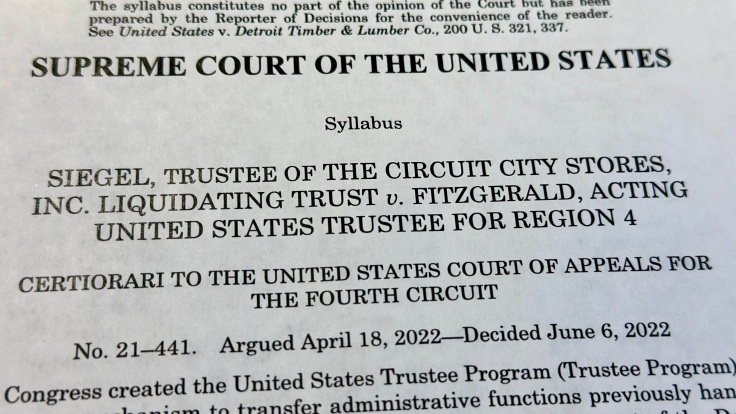
In 2022, the U.S. Supreme Court issues its unanimous Siegel v. Fitzgerald opinion. The question in that opinion is:
- whether fee increases for bankruptcy cases, that exempt cases filed in Alabama and North Carolina, are permissible under the U.S. Constitution clause requiring “uniform Laws on the subject of Bankruptcies”; and
- if not, what the remedies might be?
In its unanimous opinion, the Supreme Court declares the lower fees in Alabama and North Carolina to be unconstitutional—but it does not reach the remedies question, remanding that question instead.
Fallout on the remedies question happens during 2023 in various circuit courts:
- every circuit court addressing the remedies question says that the U.S. taxpayers will have to pay for the unconstitutional fees in Alabama and North Carolina; and
- the amount taxpayers will have to pay is well in excess of $300 million.
So . . . thanks a lot—to whomever is to blame.
Who is to blame?
So, the question becomes this: Who is to blame for the unconstitutional fee disparity?
–Footnote 2—Congress is to blame (not the Judicial Conference)
The Supreme Court answers the blame question, in footnote 2 of its Siegel v. Fitzgerald opinion, with these five points:
- “Respondent . . . argues that any uniformity violation should be attributed to the Judicial Conference and not to Congress, because Congress expected the Judicial Conference to implement the 2017 Act’s fee increase in [Alabama and North Carolina]”;
- “As respondent sees it, it is the Judicial Conference’s failure to implement the fee increase that is responsible for the disparate fees, not the 2017 Act itself”;
- “Respondent provides ample evidence that Congress likely understood, when it passed the 2017 Act, that the Judicial Conference would impose the same fee increase” in Alabama and North Carolina; but
- “That said, . . . the fee statute did not require the Judicial Conference to impose an equivalent increase” in those two states; and so,
- “It is that congressional decision that led to the disparities at issue here.”
–Footnote 2—Translation (A Very Lame Excuse)
Here’s a translation of the Supreme Court’s footnote 2 in Siegel v. Fitzgerald:
- the Judicial Conference approved the lower fees for bankruptcy cases filed in Alabama and North Carolina;
- in doing so, the Judicial Conference was well aware that:
- the Ninth Circuit Court of Appeals had already declared that lower fees in Alabama and North Carolina are unconstitutional; and
- Congress fully expected the Judicial Conference to refrain from unconstitutional behavior;
- yet, the Judicial Conference approved the lower fees in Alabama and North Carolina anyway; but
- nevertheless, the Judicial Conference is not to blame for the unconstitutionality—Congress is!!!
- That’s because Congress enacted language that did not forbid unconstitutional behavior by the Judicial Conference.
Seriously?!!!
That’s got to be the lamest excuse ever.
Why didn’t the Supreme Court just say, “A dog ate the Judicial Conference’s conscience—so, we are going to blame Congress”?
Conflict of Interest
I call, “Foul!”
Here’s a conflict-of-interest reason why.
The Judicial Conference supervises the bankruptcy courts in only two states: Alabama and North Carolina. All other bankruptcy courts in every other state and territory are supervised by the U.S. Trustee system.
Here’s what’s important to the “foul” call. The Judicial Conference functions within the U.S. Court System and under this leadership structure:
- the Chief Justice of the United States is the presiding officer of the Judicial Conference; and
- Membership of the Judicial Conference is comprised of:
- the chief judge of each judicial circuit;
- the chief judge of the Court of International Trade; and
- a district judge from each regional judicial circuit.
So, it’s not surprising that the U.S. Supreme Court blames Congress and absolves the Judicial Conference from responsibility for the unconstitutional behavior.
- It’s a conflict of interest thing: namely, protecting insiders and absolving them of their blame.
Conclusion
It’s a boondoggle.
Will anyone ever look into what happened on this within the Judicial Conference . . . and issue a report on who proposed and who decided to charge lower bankruptcy fees in Alabama and North Carolina cases, so the U.S. taxpayers might understand where responsibility lies for the unconstitutional behavior and resulting losses to the U.S. taxpayer, and how it all happened?
Ha! The answer is, “No.”
** If you find this article of value, please feel free to share. If you’d like to discuss, let me know.
Leave a comment